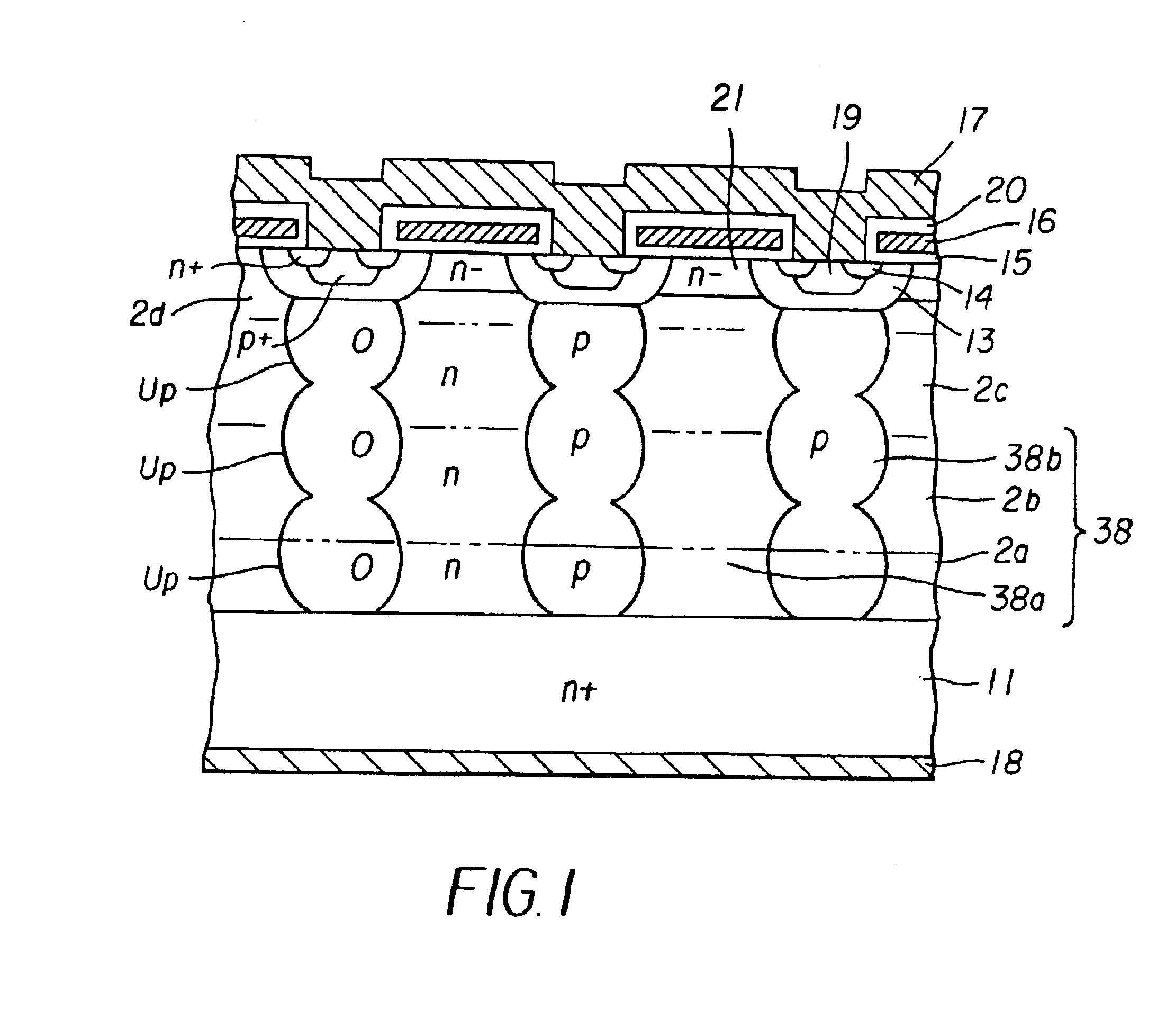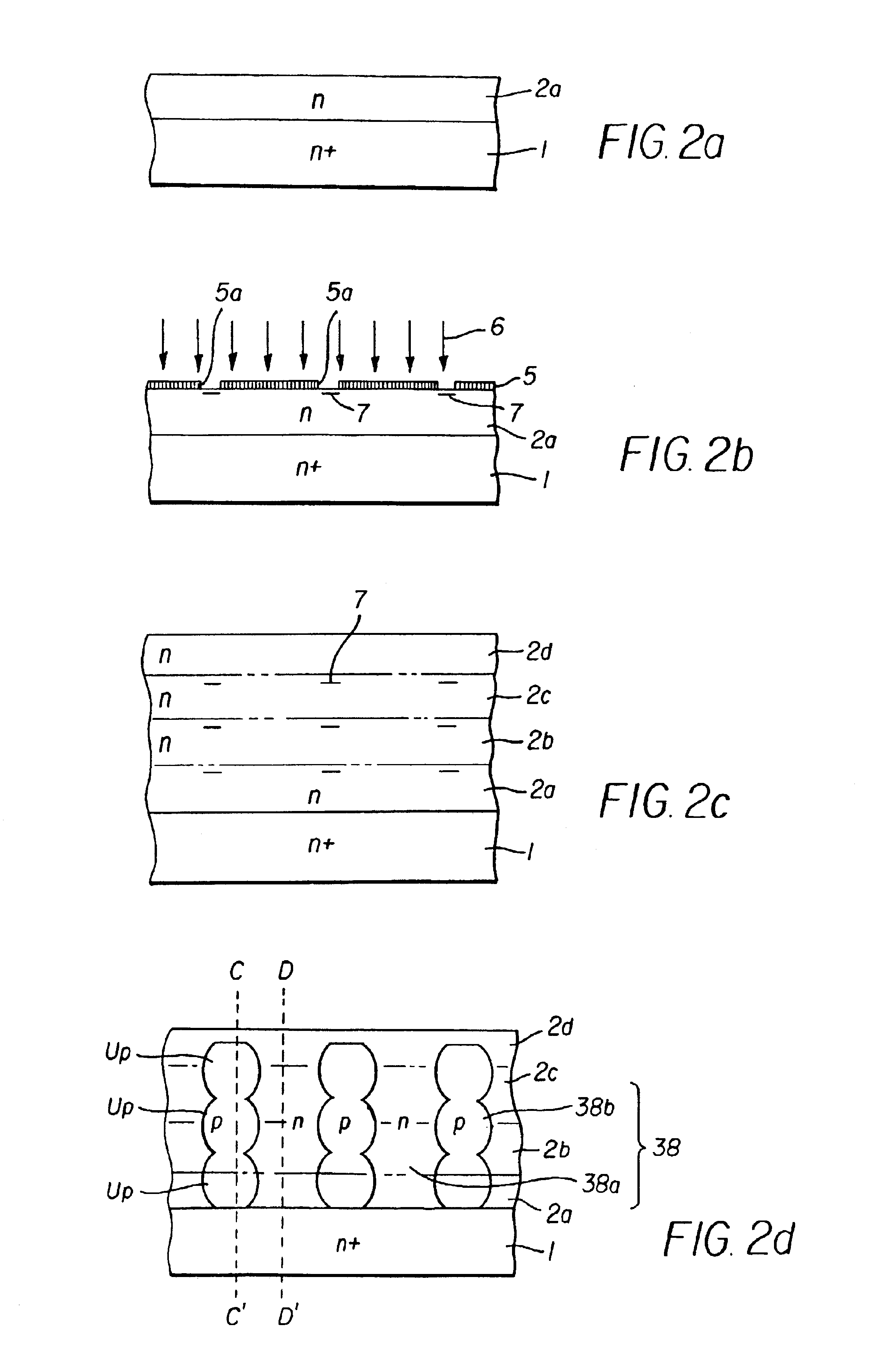Method of manufacturing a semiconductor device with a vertical drain drift layer of the alternating-conductivity-type
a technology of alternating conductivity and semiconductor devices, which is applied in the direction of semiconductor devices, basic electric elements, electrical equipment, etc., can solve the problems of increasing on-loss, difficult for the presently available selective etching techniques, and difficult for the presently available epitaxial growth techniques to grow a high-quality single crystal layer in such a narrow and deep trench. , to achieve the effect of high breakdown voltage, convenient narrowing and high current density
- Summary
- Abstract
- Description
- Claims
- Application Information
AI Technical Summary
Benefits of technology
Problems solved by technology
Method used
Image
Examples
first embodiment
[0040]FIG. 1 is a cross sectional view of a vertical n-channel MOSFET according to a first embodiment of the invention.
[0041]Referring now to FIG. 1, the vertical n-channel MOSFET includes an n+-type drain layer 11 with low electrical resistance; a drain electrode 18 in electrical contact with the back surface of n+-type drain layer 11; an alternating-conductivity-type drain drift layer 38 on n+-type drain layer 11; p-type base regions (p-type well regions or channel diffusion regions) 13 formed selectively in the surface portion of drain drift layer 38; a heavily doped n+-type source region 14 formed selectively in the surface portion of p-type base region 13; a heavily doped p+-type contact region 19 formed selectively in the surface portion of p-type base region 13; a gate insulation film 15 on the extended portion of p-type base region 13 extended between n+-type source region 14 and an n-type drain region 21 described layer; a polysilicon gate electrode 16 on gate insulation fi...
second embodiment
[0061]FIGS. 4(a) through 4(e) are cross sectional views for explaining a method of manufacturing a vertical MOSFET according to a second embodiment of the invention.
[0062]The vertical MOSFET according to the second embodiment includes a drain drift layer 48, that is different, as shown in FIG. 4(e), from drain drift layer 38 of the vertical MOSFET according to the first embodiment. Referring now to FIG. 4(e), drain drift layer 48 includes n-type drift current path regions 48a, each formed of n-type buried diffusion unit regions Un connected vertically with each other across p-type epitaxially grown layers 42a through 42d laminated with each other.
[0063]Referring now to FIG. 4(a), a p-type epitaxially grown layer 42a is laminated on an n-type semiconductor substrate 1 with low electrical resistance.
[0064]Referring now to FIG.4(b), a resist mask 5, having narrow windows 5a for ion implantation opened at a certain interval, is formed on p-type epitaxially grown layer 42a by photolithog...
third embodiment
[0070]FIGS. 5(a) through 5(f) are cross sectional views for explaining a method of manufacturing a vertical MOSFET according to a third embodiment of the invention.
[0071]The vertical MOSFET according to the third embodiment has the same structure with that of the vertical MOSFET according to the first embodiment shown in FIG. 1. In forming the alternating conductivity type layer of the vertical MOSFET according to the first embodiment, n-type epitaxially grown layers 2a through 2d are laminated. In forming the alternating conductivity type layer of the vertical MOSFET according to the third embodiment, a step of laminating an n-type layer and a steps of implanting n-type impurities into the entire surface portion of the as laminated n-type layer are repeated.
[0072]Referring now to FIG. 5(a), a first n-type layer 2a′ is epitaxially grown on an n-type semiconductor substrate with low electrical resistance.
[0073]Referring now to FIG. 5(b), n-type impurity phosphorus ions 3 are implante...
PUM
 Login to View More
Login to View More Abstract
Description
Claims
Application Information
 Login to View More
Login to View More - R&D
- Intellectual Property
- Life Sciences
- Materials
- Tech Scout
- Unparalleled Data Quality
- Higher Quality Content
- 60% Fewer Hallucinations
Browse by: Latest US Patents, China's latest patents, Technical Efficacy Thesaurus, Application Domain, Technology Topic, Popular Technical Reports.
© 2025 PatSnap. All rights reserved.Legal|Privacy policy|Modern Slavery Act Transparency Statement|Sitemap|About US| Contact US: help@patsnap.com



